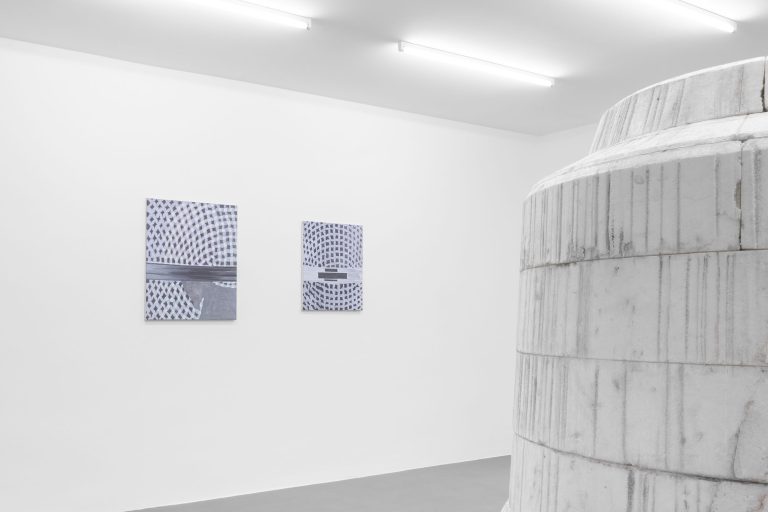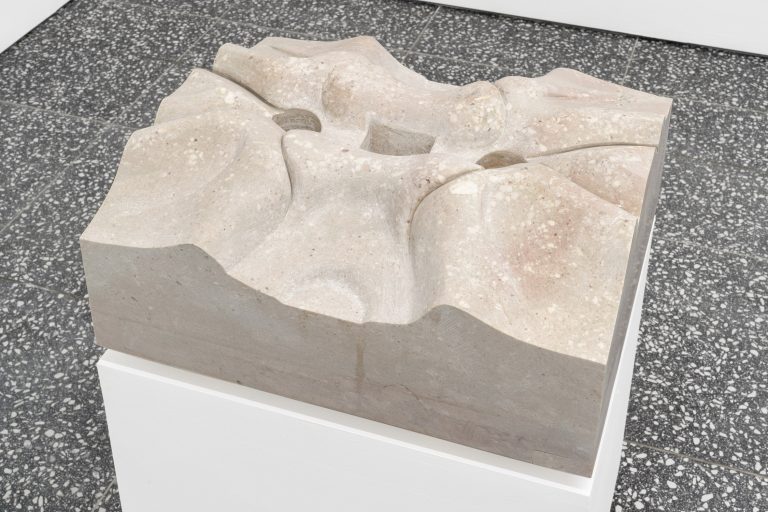Artist: Anne Speier
Curated by: Bettina Spörr
Venue: Secession, Vienna, Austria
Date: September 14 – November 4, 2018
Photography: all images copyright and courtesy of the artist and Secession, Vienna
Many of Anne Speier’s works document the distensions and deformations that objects and figures undergo in order to both understand and transcend the limitations of the meaning ascribed to them, their potentials and interrelations. Yet the artist also subjects the media she works with to such stretching. Aesthetic qualities are one way to defy certain expectations; absurdity and otherness are another.
In her exhibition in the Secession’s sublevel gallery, Speier intertwines painting and sculpture in a kind of utopian architecture, short-circuiting its spatial premises with its metaphorical purport. The show examines the challenges that teachers and students at art schools face along images and installations that limn psycho-emotional topographies.
They counter the distrust of art education and the associated hierarchical understanding of aesthetic phenomena with an ambivalent desire for the responsibility that is needed for analyzing the objects in one’s environment and making something new out of them.
The point of departure is an empty space rendered in a series of industrially manufactured silkscreen prints on various media in colors determined by an algorithm. These elements serve to furnish the existing underground space with architectural components: exterior façades that address persistent stereotypes; niches in which scenes from a school production play out; roofs and additional basements. The middle of the room, the central and representative scene of the exhibiting institution, remains as a figurative blank space.
The exhibition opens with a room that conveys an impression of a building’s “exterior” with an ensemble of three paintings. Two pictures, on the right and left, show figures holding up a structure or institution. The reference is to a scene in Agnès Varda’s film “Les dites cariatides” (1984) and the titular caryatid, a sculpted female figure serving as an architectural support. Such figures are often set in symmetrical arrangements but rarely identical, propping up a portal as doorkeepers or framing a window. What made them interesting to Varda is that they look good doing what they do and seem fairly relaxed. Labor is often not recognizable as such in the final result: that is the theme of a picture between the caryatids addressing the questionable fictions that lie dormant in art-making’s unconscious. It shows a group of women drinking tea while dismantling a building: industry is genius’s ugly sister. The bird’s-eye perspective suggests a survey of structures that uncovers their secret rules and mechanisms.
In the pictures emerging between these elements, rampage seems to be in the air. The motif derives from a South Park episode that first aired in September 2017. It begins with a scene in which the high school’s students collectively overturn their lockers and set scattered papers on fire to protest the cancellation of their day off on a politically incorrect holiday. The episode traces the complete arc from paranoia across the characters’ latent ambivalent feelings about themselves to a counterproductive outburst of violence. The riot that ensues is an expression of defiance; though bound to fail, it makes for a good mental image of the fantasy of refusing to submit or function. Burning paper appears in Speier’s pictures with some frequency, hovering above the figures like a gentle reminder that change is always possible.
The picture with the cock the visitors need to squeeze past on their way to the next room can serve to represent the pushiness of intended meanings implanted in art; later on, a dying lobster is a pretty good example of how the painted figure is put on, inserted into space. It also raises the curtain on the school production, fragmentary documentation of which appears in the paintings in the large gallery. They are snapshots from a series of ill-conceived or certainly not yet entirely functional scenes of a musical. The plotline loosely weaves around the act of ordering lobster in a bad restaurant. Everyone present (cooks, wait staff, patrons, owners, animals) panics because this has never happened before. The lobster must say farewell to life; the restaurant’s operator, to the notion that hers is a unique establishment serving fine cuisine; the diner, to the idea of pleasant taste. The pictures/niches along the walls illustrate how the performers—genuine and pretend lobsters and other animals—break out in elegies about love, death, and rebellion. They may be said to enact crucial moments in an aesthetic education that can never proceed independently of a canon of formal codes, organizing not just art but also the individual’s social habitus.
The roof sculptures in the floor installation take this challenge to and inquiry into the bounds of the space/the institution further, encountering hierarchies as structures that define space, deferring to them, but also ignoring or flouting them. What is quite manifestly happening here is a displacement of the center. The floor panels on which rooms are printed add another sublevel to the Secession’s basement, while the roofs turn that basement itself into an intermediate floor. The resulting space remains vacant and may be read as a crisis of the prevailing order or as a blank slate awaiting future events and uses, for example for the own art.
Pedagogy, creative labor, and the unconscious, whose traditional home is in the metaphorical underground, trisect a possible version of postmodern subjectivity. The sublevel installation employs these factors to play off the putatively settled relationship between individual and institution against its unpredictability.
(Text: Inka Meißner)
Anne Speier was born in Frankfurt am Main in 1977 and studied at Frankfurt’s Städelschule. She currently lives in Vienna, where she teaches in the Object Sculpture Studio at the Academy of Fine Arts.
Anne Speier, installation view Secession 2018, photo: Secession, Courtesy the artist and Galerie Meyer Kainer
Anne Speier, exhibition view Secession 2018, photo: Secession, Courtesy the artist and Galerie Meyer Kainer
Anne Speier, installation view Secession 2018, photo: Secession, Courtesy the artist and Galerie Meyer Kainer
Anne Speier, installation view Secession 2018, photo: Secession, Courtesy the artist and Galerie Meyer Kainer
Anne Speier, installation view Secession 2018, photo: Secession, Courtesy the artist and Galerie Meyer Kainer
Anne Speier, installation view Secession 2018, photo: Secession, Courtesy the artist and Galerie Meyer Kainer
Anne Speier, installation view Secession 2018, photo: Secession, Courtesy the artist and Galerie Meyer Kainer













